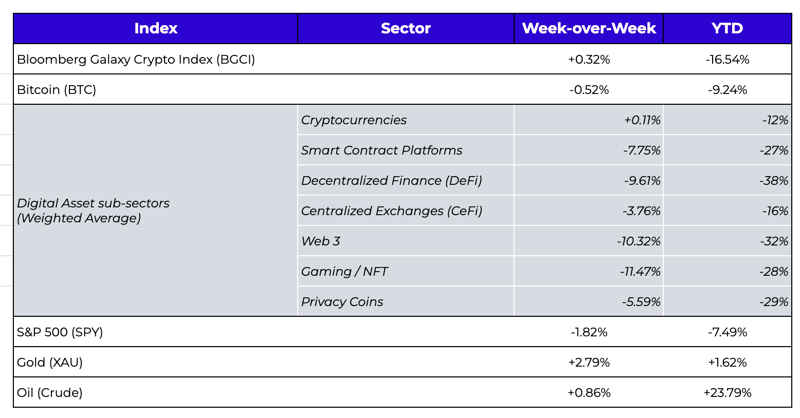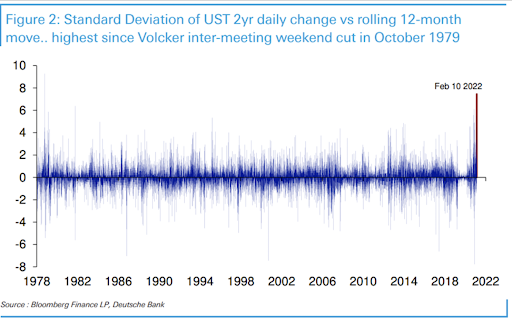
 What happened this week in the Digital Assets market
What happened this week in the Digital Assets market
Week-over-Week Price Changes (as of Sunday, 2/13/21)

“Bitcoin and digital assets appear to be trading more like macro assets, in large part because the biggest tailwinds that propelled them to new highs over the last 18 months have strong crossovers with those driving traditional risk assets like equities. That said, investors should brace for a world where the sectors within crypto—BTC, ETH, DeFi, NFTs, L1/L2—start behaving more independently as correlations between different crypto sectors start to weaken. Fundamentals were almost a running joke in the early days of the crypto market. Now, we’ve reached a point where protocols generate significant value in wholly unique ways. Investors will begin to recognize this, the same way they recognized that stocks in different sectors will exhibit unique return patterns, and will be benchmarked accordingly (e.g. how a SaaS company’s revenue and cash flow are entirely different from a global retailer’s). In the coming years, crypto investing will be no different.Broadly, there’s a growing divergence between ‘macro crypto’ and ‘web3 crypto.’ Macro crypto (think BTC) will continue to be impacted by key macro factors, whereas the impact on the broader crypto market will depend more on the type of asset or protocol and whether or not such events directly impact its value proposition. In other words, the success of these dapps and protocols will be determined more by adoption and usage activity rather than the same macro factors impacting BTC.Part of this divergence narrative will be driven by ‘smart money’ that recognizes the potential for crypto’s outsized returns. The days of classifying everything as either Bitcoin or “something trying to be Bitcoin” are long gone. Investors will realize that, unlike traditional equity, most crypto assets are designed to be productive assets, and the use cases (or utility) of these assets varies by application or protocol. Sure, you can take a buy-and-hold approach, but in order to participate in many of these networks (or at minimum avoid dilution), you need to do something with the native asset that contributes to its success (such as staking or providing liquidity, for example). One of the big unlocks in crypto is greater capital efficiency, and smart investors will come to realize this.That’s not to say macro factors won’t impact the broader crypto market. After all, we know rapid liquidity growth can be a strong tide that lifts all boats. Specific sectors and their underlying assets will stand to benefit from strong fundamentals, creating a ripe environment for active management if you know how to spot trends early.”

“There is a strange debate about crypto and money laundering. Crypto skeptics will often say “Bitcoin is mostly useful for money laundering”; crypto proponents will occasionally say “what of it, money laundering is fine, freedom, man,” but mostly they will instead say “no, Bitcoin is useless for money laundering because it creates a permanent public record of all transactions and why would you want to launder money that way.”You might think that a federal criminal indictment for $4.5 billion of Bitcoin money laundering would be vindication of the “Bitcoin is for money launderers” side, but I want to tell you: No it is not! What allegedly happened here is that hackers stole $4.5 billion of Bitcoin from a crypto exchange (and stealing from exchanges absolutely is a major function of crypto), and then they had a horrible time laundering it. They managed to extract only a relatively small portion of the money for actual spending, and each time they got money out the feds were able to trace it from the hack all the way to legitimate accounts with their names on it. The laundering efforts were small-scale, and they are also how they got caught.If you rob a bank and steal a sack of money and the bills are sequentially numbered and a dye pack explodes in the sack and you drive directly to another bank and hand them the dye-stained sack and say “I’d like to make a deposit please” you will totally get arrested, and you will probably get charged with money laundering, but in no meaningful sense did you launder the money. It still has the dye on it! That is what happened here.”

Watch Our Founders Video
Disclaimer: This commentary is provided as general information only and is in no way intended as investment advice, investment research, legal advice, tax advice, a research report, or a recommendation. Any decision to invest or take any other action with respect to any investments discussed in this commentary may involve risks not discussed, and therefore, such decisions should not be based solely on the information contained in this document. Please consult your own financial/legal/tax professional.
Statements in this communication may include forward-looking information and/or may be based on various assumptions. The forward-looking statements and other views or opinions expressed are those of the author, and are made as of the date of this publication. Actual future results or occurrences may differ significantly from those anticipated and there is no guarantee that any particular outcome will come to pass. The statements made herein are subject to change at any time. Arca disclaims any obligation to update or revise any statements or views expressed herein. Past performance is not a guarantee of future results and there can be no assurance that any future results will be realized. Some or all of the information provided herein may be or be based on statements of opinion. In addition, certain information provided herein may be based on third-party sources, which is believed to be accurate, but has not been independently verified. Arca and/or certain of its affiliates and/or clients may now, or in the future, hold a financial interest in investments that are the same as or substantially similar to the investments discussed in this commentary. No claims are made as to the profitability of such financial interests, now, in the past or in the future and Arca and/or its clients may sell such financial interests at any time. The information provided herein is not intended to be, nor should it be construed as an offer to sell or a solicitation of any offer to buy any securities, or a solicitation to provide investment advisory services.
These Stories on Market Recap